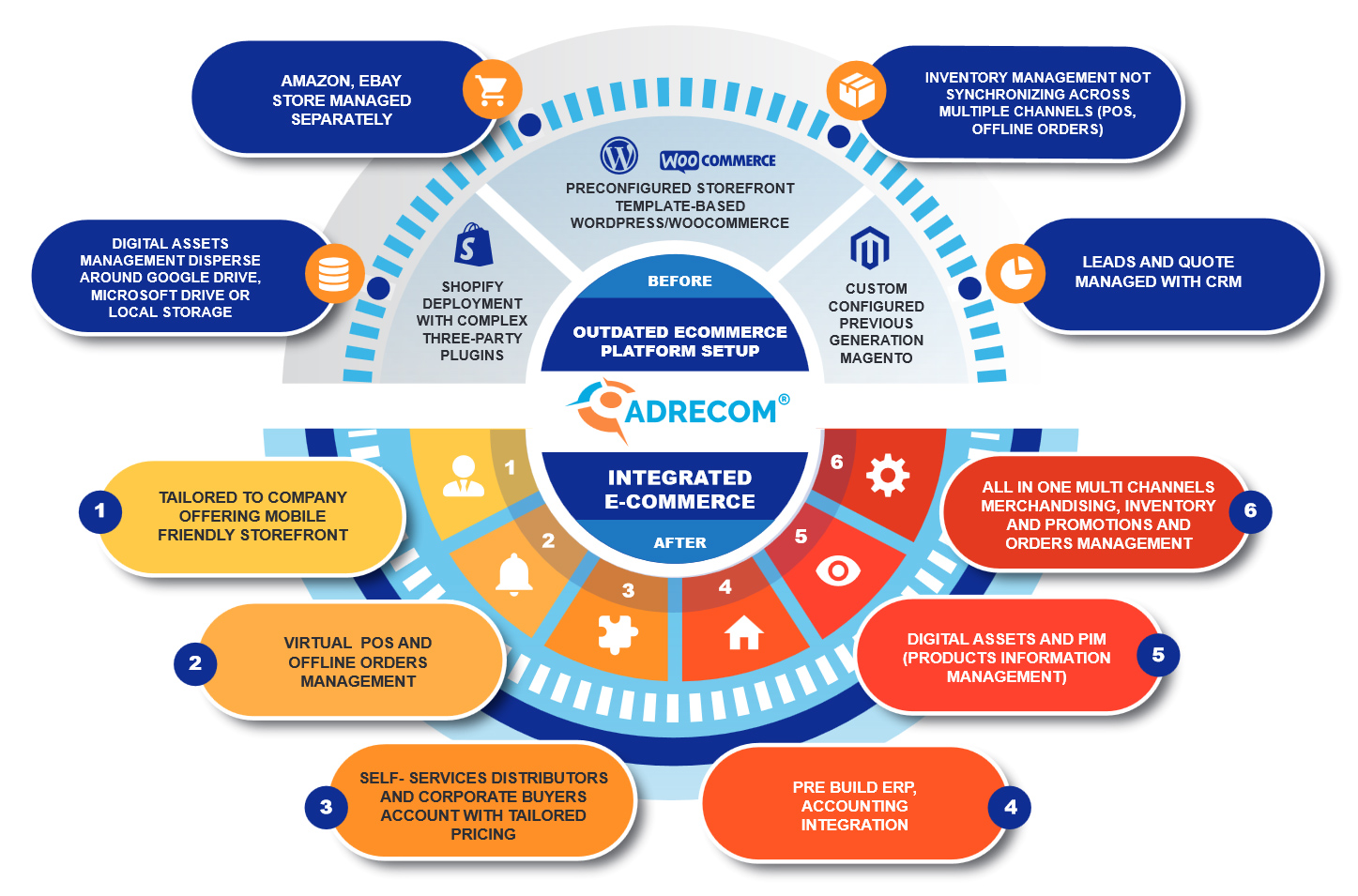
Just like your computer, your E-Commerce Store needs updates too.
E-Commerce is the future of businesses. More and more consumers are shifting to online shopping than going to big-box, brick-and-mortar stores. In fact, in 2020, experts projected that worldwide e-commerce sales reached 4 trillion.
With that, it is critical to know whether a company’s e-commerce website is truly helping them attain its goals. Accurately perceiving when an e-commerce store needs an upgrade or needs to migrate entirely can make all the difference in treading the line separating rapid and steady growth or painfully stagnant sales. It is necessary to keep abreast of the state-of-the-art features and web standards that emerge each year to stay ahead of the competition.
Which Type of Upgrade Do I Need?
Managing an e-commerce store is no easy job. Among the most prevalent issues circling e-commerce is the management of the digital storefront. A high-functioning website is one that successfully funnels traffic into the company’s pages and improves overall sales. On the other hand, a low-quality site does otherwise. In the instance that a company’s marketing tactics or web and mobile UX/UI enhancements yield less and less return, it may be time for the website to undergo software and technical upgrades.
An upgrade can involve renewing a company’s existing e-commerce software, thereby opening new opportunities for scale and growth, such as advanced order handling, international shipping, and multiple storefronts, among other things.
When upgrades just would not do, migrating to a new, better platform might be inevitable. Companies can use the latest feature sets and tools that are most likely being employed by other competitors.
Although risky, transferring to another platform, specifically a custom site, can sometimes be the change needed to bring your businesses to greater heights. A custom site utilizing the most recent web standards, user privacy policies, and page load times generally improve user experience.

What are the Tell-Tale Signs that an Upgrade is Needed?
Growing out of the business’ current e-commerce system is a good sign. However, you cannot sustain this growth unless the industry evolves with increased demands. That is why business owners must gauge the limitations of their current system and address them efficiently. Moreover, here are some signs that signify that it may be time for an e-commerce store to undergo further developments:
Outdated Web Design
Among the signifiers that an e-commerce site needs an upgrade is outdated web design. When a website’s look is not effectively communicating a company’s brand, especially among the younger, technology-savvy customers, it may be time for a makeover. To overcome this issue, companies can post more photos of their products or services. However, high-resolution images can create a lag whenever clicked. Thus, it may be best to cut the photo’s size down and set them at 72-pixel resolution. After all, there is no need for full-size pictures when users check out a product on their phone.
Limited Website Functionality
Another problem that companies may encounter is that their website is not mobile-friendly or has issues with adherence to current SEO requirements. The best way to ensure the website’s functionality across devices is for companies to use it as a customer would. If any layout issues arise, such as buttons being too small, adjust them accordingly.
Website Cannot Keep Up with Market Trends
Although online shopping is increasingly becoming the new normal for most customers, it is still contingent on market trends. Depending on current trends, some items will be in demand, while others might trail off for a while.
Consequently, businesses may notice an increase in the number of abandoned orders, an increase in the rate of website leaving upon page entry, succeeding questions from customers between the lines of “can’t find products,” and an increase in check-out issues. Moreover, long-term customers with a history of recurrent purchasing may buy less, or ultimately, stop buying, thereby resulting in a significant conversion rate drop.
While specific causes for significant drops may vary, here are some ways to unearth the root of the problem:
A/B Testing
This process involves the creation of two sets of similar pages but with contrasting layouts. By allowing half of a website’s traffic to each one, business owners can pinpoint which page has the most engagement. When executing A/B testing, it is critical to focus on incremental changes. Doing too much at once will have a hard time attributing which adjustments create the most impact.
Cut Underselling Products
Generally, the key to a successful e-commerce store is to focus on a specific niche. With corporate giants like Amazon and Wal-Mart already selling everything, it may not be in a company’s best interest to spread its inventory too thin. Rather, it may be wise to check on the current sales charts and eliminate anything that does not sell. Doing so can simplify and streamline the shopping process, thereby allowing customers to find what they want much easier.
Website is Too Complex to Maintain
Another source of problems comes with website look and feel modification, promotion configuration, and product catalog management. A well-designed website allows a company to make swift changes on its own intuitively. On the contrary, a website that requires web developers and professionals even when making minute changes does not only cause a hassle but also adds unnecessary expenses.
Website Requires Constant Management
An effective e-commerce website can easily integrate with third-party services. However, too many third-party plug-ins require constant attention, and communication with third-party providers is unideal.
This deal devotes more time to dealing with technological issues and coordinating between marketing teams, tech teams, and third parties than doing higher-value tasks such as serving customers or developing sales channels. Moreover, one of the most common reasons customers churn is a slow, complicated check-out system. In times like this, A/B testing can be of great use in figuring out which elements to keep and which to discard.
Limited Expansion Capabilities
Another e-commerce issue is limited expansion capabilities, such as leads to quote management and distributor portals. Although one e-commerce platform may have been pivotal in helping a company achieve its first $1 million in sales, the same platform may not be of the same help when reaching $10 million. As businesses grow online, some of the processes may require more in-depth tools. Thus, a direct relationship must exist between a company and its website. That way, as a business grows, its website design evolves, too.
Sale Channels Separated or Sale Channels Not in Use Yet
Omnichannel e-commerce is a unified e-commerce platform allowing access to customers no matter which digital device or platform they are using. Omnichannel e-commerce is important because studies show that 73% of online shoppers use multiple channels while shopping online. With an omnichannel e-commerce strategy, companies can foresee that customers may start searching from one medium to another due to their online shopping journey, thereby allowing them to make more informed decisions and undertakings.
More specifically, the advantages of establishing an Omnichannel E-commerce strategy include:
Cohesive Message
One of the principal benefits of employing omnichannel e-commerce is companies can provide customers with a consistent, cohesive messaging about their brand. No matter what platform customers encounter their brand, companies ensure that the messaging is consistent and always the same.
Understanding your Customer Journey
With an omnichannel e-commerce strategy, companies can collect and incorporate customer data across multiple channels. This data gives a complete picture of the kinds of customers interested in a company’s brand and their behavior, giving companies the advantage of personalizing customer shopping journeys.
Personalizing the Customer Experience
Personalizing customer experiences are made possible by understanding the customer journey. Creating a personalized experience among omnichannel customers is vital as they possess a 30% higher lifetime value than customers who only use one channel for purchasing.
If these signs are present on a company’s website, it is time to consider redesigning or migrating the website. By ensuring the effectiveness of an e-commerce website, businesses can benefit from increased sales and earn a following of loyal customers.
E-commerce Upgrades Are a Must For Everyone
The latest technological advancements have made it inevitable for businesses to enter E-commerce. With the competition shifting towards a digital landscape, entrepreneurs must invest in e-commerce development to thrive and keep afloat in the competitive market. As the world braves through the current pandemic times, online businesses must keep the market going. To stand out in the sea of online competitors, companies must constantly find ways to better their services, such as upgrading and enhancing their e-commerce websites.
In summary, investing time, effort, and money in upgrading e-commerce stores is advantageous despite its digital business stage. Whether you are big or small, it is vital to continue innovating your E-commerce and look toward the future. E-commerce upgrades are not a one-time event but an ongoing strategy for keeping a competitive stance in the online market.




